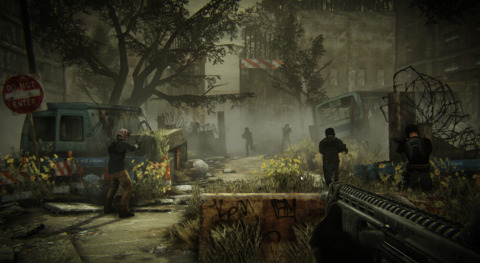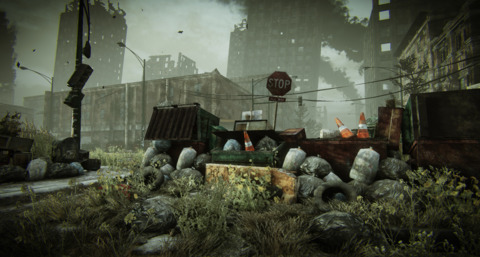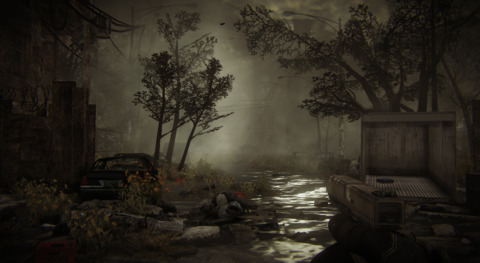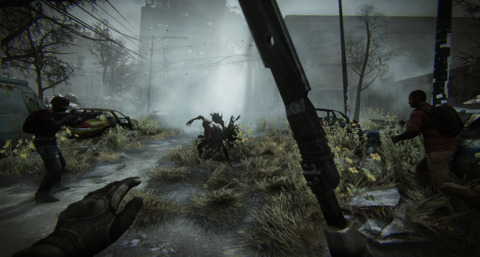A Journey to the Nether Regions of the Mutant Apocalypse
With elements of DayZ and Left 4 Dead in its DNA, Nether presents an interesting take on the multiplayer survival simulator.
I know what you're thinking. Someone mentions a new multiplayer survival game set in a postapocalyptic world that's overrun with subhuman creatures nipping at your heels, and your first assumption is "been there, done that." But then a game like Nether comes along. Its mix of design philosophies, which falls somewhere between the frenetic nature of Left 4 Dead's action and the cautious play favored by DayZ, could inject this subgenre with some new life.
FINAL FANTASY VII EVER CRISIS | Ever Crisis Academy Seven: Episode – Brawler Event Coming Soon WUCHANG: Fallen Feathers - Bride Boss Fight Gameplay Trailer Street Fighter 6 - Elena Gameplay Reveal Trailer Overwatch 2 - Official Gundam Wing Collaboration Gameplay Trailer Madden 26 & College Football 26 - Official Announcement Trailer | "The Call" The Crew 2: Offline Mode Update Overview Trailer Capcom Fighting Collection 2 - CvS And CvS2 | Game Spotlight Trailer Micromega - Official Announcement Trailer AI:THE SOMNIUM FILES - Sleep For Kaname Date – Intro Trailer ELDEN RING NIGHTREIGN | Recluse Character Gameplay Trailer Ghost of Yotei - The Onryos List | Release Date Reveal Trailer The Hundred Line -Last Defense Academy-: Official Launch Trailer
Please enter your date of birth to view this video
By clicking 'enter', you agree to GameSpot's
Terms of Use and Privacy Policy
Crumbling walls and forgotten streets draped in fog dress the world around you. An unexplained cataclysmic event 10 years in the past, known as the "Call," befell civilization. A large part of the population mutated into twisted creatures, known as the nethers, whose sole desire is the eradication of the remaining survivors. These abominations come in different stages of mutation, effectively acting as classes with varying abilities, but two constants apply across the board: every nether is blind and is capable of teleporting short distances. Despite their inability to see, the nethers' enhanced hearing lets them easily identify noisy players. Therefore, it may be a bad idea to sprint through town with your finger on the trigger.
Nethers are fast-moving, hard-hitting, and persistent buggers. The crucial distinction between nethers and zombies--even the fastest ones--is the aforementioned teleportation ability. Because of this, they can easily move into your blind spots, and running is hardly an option. Hunter nethers make flight particularly challenging, given the class's advanced tracking abilities and strength, and the diminutive shrieker alerts other nethers nearby with a high-pitched howl. In most cases, your only recourse is to stand your ground and eliminate the threat as quickly as possible. If you can do it silently, say with a kitchen knife, even better, but it won't be easy. Even a single nether poses a significant threat to you, making the use of firearms an attractive, albeit risky, proposition.

Nether is as much about defending yourself from other players as it is about fighting off deadly creatures. It's a scenario that breeds teamwork, but also paranoia. Imagine that your neighbors, who have covered your back on more than one occasion, seem a little too interested in your cache of supplies. Do you second-guess your suspicions, or eliminate your closest allies just in case they're cooperating under false pretenses? It should come as a relief to some players to know that death doesn't impact your progress as much as it does in a game like DayZ, but it's not to be taken lightly. Though you hold onto your cash and skill levels postmortem, all of your equipment is up for grabs when you bite the dust. Have fun respawning at a random point on the game's sizable map, too.
The Chicago-inspired metropolis in Nether is an incredibly large and dense environment. Buildings line every block, each containing multiple floors, and according to the game's director, Chip Sineni, every room, staircase, and corner is accessible. Safe zones are available if you want to hang back and secure items indefinitely, but the vast majority of the map is a hostile environment. Yet, missions and the need for supplies force you out into the world, so it's expected that you'll spend a lot of time away from home. It's possible to fortify and hold entire buildings, if you're up to the challenge, but your hard work could easily become a target for other players. The verticality introduced by multistory buildings can turn a single building into a complex micro-society, and if the 64 players on a given server are feeling particularly aggressive, you may even find multiple conflicts springing up on a single block. Then, when you least expect it, a group of nethers will show up to ruin the party.


Development on Nether is still early, which affords Phosphor Games a bit of fluidity where design is concerned. Sineni emphasized their willingness, and desire, to incorporate community feedback into the development process moving forward. In fact, the first video footage on YouTube caused quite a stir among its audience, leading to the elimination of a significant feature: the ability to switch between first- and third-person views. Where player versus player is concerned, such a feature would give an unfair advantage to anyone playing in a third-person perspective, and give players who like the immersive quality of a first-person perspective the short end of the stick. When enough people raised their voices in defiance, the option for a third-person camera was thrown out the window, which is a testament to the validity of Phosphor Games' promise.
Sineni was quick to point out that any requests with enough support will be considered. If, for example, enough people want to play with fantastical weapons and abilities, Phosphor Games will do its best to accommodate those players, perhaps on a server-by-server basis, without interrupting the rest of the community. Sineni and his team are hoping to get a beta version of Nether into your hands as soon as possible, with a rich forum, to get the collaboration ball rolling. When it does hit the market, Nether will be sold for an upfront cost--no subscription fees or free-to-play models. It will be possible to rent servers, but that's currently designed to give people an easy way to host private matches. With persistent characters, it makes mod support for private servers a tough challenge to resolve. However, if the community presents a solid solution, there's always a chance Nether will gain mod support down the road.

Nether deviates just enough from other multiplayer survival games to stand on its own for now, but with so much competition from games such as State of Decay and Day Z, and the upcoming Tom Clancy's The Division tackling urban survival sometime next year, there's a chance Nether will find itself outnumbered before too long. If anything, Phosphor Games' pledge to adapt to the community potentially gives Nether an edge over the competition, but the efficacy of their promise relies on players' willingness to participate and ability to wait for results. Unfortunately, it's going to be an uphill battle. Patience is a rare virtue, and with a healthy lot of competition, it will take a considerable effort for Phosphor Games to corner the market on one of gaming's most popular subgenres.
Got a news tip or want to contact us directly? Email news@gamespot.com
Join the conversation